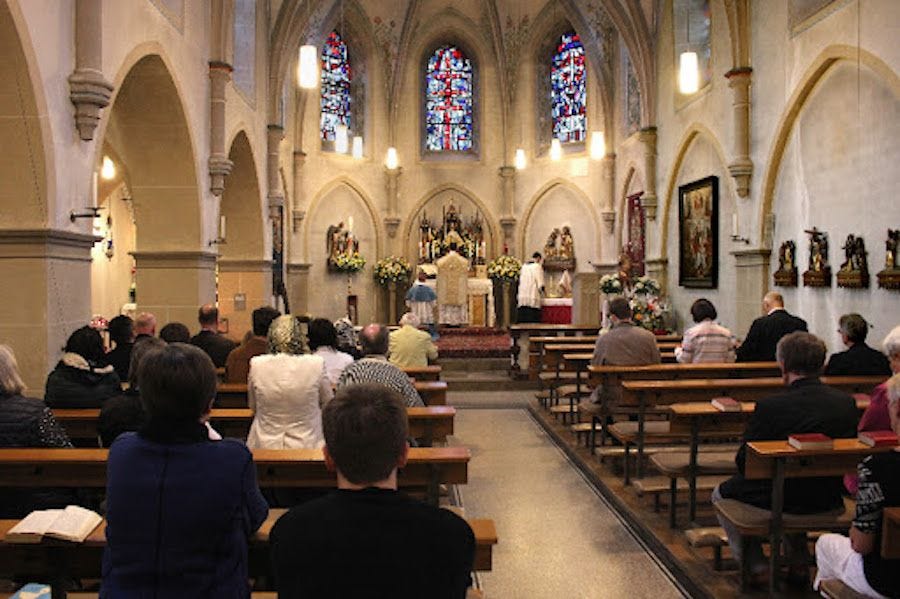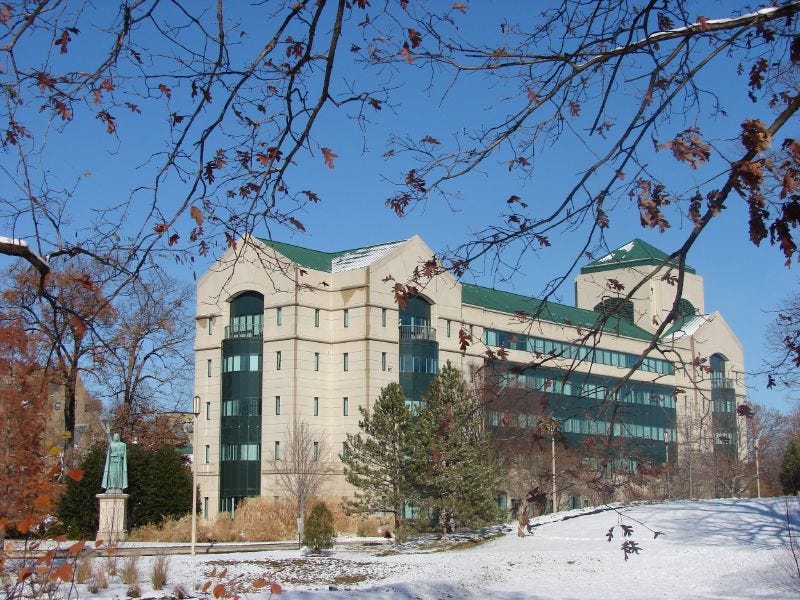
If you are ever browsing at a newsstand in a big German train station, look out for a magazine called Dominus Vobiscum.
The cover is likely to feature a photograph of a Mass, or perhaps a statue of a saint, or a page from a medieval manuscript.
Beneath the image will be a line explaining that the magazine is produced by Pro Missa Tridentina, a lay association dedicated to “the Classical Roman Rite in the Catholic Church.”
The magazine is one proof that there is more to German Catholicism than the “synodal way,” the headline-grabbing initiative bringing together the country’s bishops and lay people to discuss far-reaching changes to Church teaching and practice.
That a magazine promoting the Traditional Latin Mass (TLM) can be found at the country’s railway stations shows that Germany is also home to a small but lively group devoted to the Extraordinary Form of the Roman Rite — the celebration of sacraments using liturgical texts which were published before the Second Vatican Council.
What is it like to be a traditionalist in a country synonymous with Catholic progressivism?
What do German traditionalists make of the synodal way?
And how strong is the traditionalist movement in Germany compared to other countries?
The Pillar spoke with German traditionalists in search of the answers.
📰
–
‘A negative aura’
Monika Rheinschmitt, a founding member and president of Pro Missa Tridentina, explained to The Pillar the resonance of a word like “traditionalist” in Germany.
“As far as I know, in the English-speaking world the use of ‘traditionalist’ is normal and has no bad connotations,” she said in an email interview. “In Germany, nearly all expressions with ‘-ist’ at the end have a negative aura or connotation, e.g. like ‘terrorist,’ extremist.’”
“You can take positive words like ‘rubric’ and if you add ‘-ist’ you get the negative version: a ‘rubricist’ is a person who exaggerates the importance and the implementation of rubrics to the point it is more hurting than helping the liturgy.”
“The same happens to ‘tradition’ and ‘traditional’ if you add ‘-ist’: ‘Traditionalists’ are people who are focused in a negative way on tradition, maybe understanding it wrongly as ‘return into the 1950s,’ sometimes giving the impression of being kind of ‘Catholic Amish’ people. Traditionalists are said to be stubborn with weird, strange opinions.”
The German synodal way’s “orientation text,” which sets out the initiative’s fundamental principles, portrays traditionalism as wrongheaded, perhaps even foolish.
“Tradition is not inflexible, it is a living thing,” it says. “Traditionalism is wrong to only recognize the penultimate phase of Church history as binding in most cases, thus curtailing the richness of tradition or forcing it into the corset of a system.”
Rheinschmitt, who is also a council member and treasurer of the International Federation Una Voce (FIUV), suggested that Germany was one of the three most prominent centers of traditionalist Catholicism in Europe, alongside France and the U.K.
She pointed out that Germany is home not only to the first seminary of the Priestly Fraternity of St. Peter (FSSP), in Wigratzbad, but also, in Zaitzkofen, a seminary of the Society of St. Pius X (SSPX) — a traditionalist group of clerics with a rocky history and no official canonical status in the Catholic Church.
Bishop Athanasius Schneider, one of the world’s most well-known traditionalists, is based in Kazakhstan, but his parents were Black Sea Germans. And Robert Spaemann, the influential Catholic philosopher and Traditional Latin Mass supporter who died in 2018, was born in Berlin.
Another prominent German advocate of the traditional liturgy is Martin Mosebach, author of the influential book “The Heresy of Formlessness.”
He told The Pillar that Germany’s role in the global traditionalist movement was “not as important as the French and the North American, but still not negligible.”
He noted that in addition to the seminaries at Wigratzbad and Zaitzkofen, there is a traditionally inclined monastery in Reichenstein and convent at Maria Engelport.
“In all large German cities and in many smaller towns one finds the Old Mass,” he said via email. “Of greatest importance for the persistence of the ancient rite was the work of the German Joseph Ratzinger as cardinal and prefect of the Congregation for the Doctrine of the Faith and as pope.”
–
A Benedict bounce
Benedict XVI’s most famous contribution came in 2007, when he released the apostolic letter Summorum Pontificum, which said that Mass according to the 1962 Roman Missal had never been abrogated and could be celebrated as “an extraordinary form of the Church’s Liturgy.”
Rheinschmitt explained that after Summorum Pontificum, German traditionalists made great efforts to make the older form of the Mass available to as many people as possible. They helped groups of lay Catholics to establish regular Masses in cities across Germany, as well as offering training to priests, altar servers, and choir members getting to grips with Gregorian chant.
“This was quite successful, so that the number of TLM locations in Germany went up significantly,” Rheinschmitt said.
She added: “The traditional groups and practice increased about tenfold since the motu proprio Summorum Pontificum in 2007. As today only 1-3 % (that depends on the counting method) of nominally Catholic people in Germany show up on Sundays at Holy Mass and receive the other sacraments, the importance and weight of traditional faithful is increasing — the same effect as nearly everywhere in the Catholic world.”
“A big problem in Germany (as maybe in other countries as well) is that still many Catholics just don’t know about the vetus Ordo [TLM] – first, its existence, and second, that it is not forbidden. So one of our great challenges is to try and reach them.”
There appears to be no reliable estimate of the total number of Catholics attending the older liturgical form in Germany.
The German bishops’ conference reported in June that at the end of 2021, there were 21.6 million Catholics in the country out of a population of 83.2 million. That year, a record 359,338 people formally left the Church. If we assume that there were not many traditionalists among them, then the proportion of traditionalists within the German Church could possibly be slowly increasing — though this is speculation.
Anecdotal evidence suggests that traditionalists remain a very small minority in Germany.
Rheinschmitt said she thought that Germans were attracted to the older liturgy for the same reasons as Catholics in other countries.
She said: “The more the official church talks about themes like environment, migration, and LGBTQIA, the more the services on Sundays are transformed into events around these themes, garnished with the personal likings and ideas of the priest -if there is still a priest and not some lay person leading the service - the more Catholic people are attached to the reverent and solemn celebrations of Traditional Latin Masses where God stands at the center.”
Martin Mosebach said that German Catholics appeared to be drawn by the promise of sound doctrine.
“My guess is that German Catholics are attracted less by the beauty of the traditional liturgy than by its sure orthodoxy at a time when the entire doctrinal edifice of the Roman Church seems to be slipping,” he commented.
“Especially in the southern and western German homelands of the Catholic Church, people seem to be less sensitive about liturgical purity if only the doctrinal content is fully preserved.”
—

📰
After ‘Traditionis custodes’
How have German devotees of the older Mass been affected by Traditionis custodes, Pope Francis’ 2021 motu proprio curtailing “the use of the Roman Liturgy prior to the reform of 1970”?
According to the website Traditioniscustodes.info, which monitors the motu proprio’s application worldwide, only eight of Germany’s 27 dioceses and archdioceses have responded publicly to the papal document. Just one — Magdeburg — restricted Traditional Latin Masses, the website said.
Yet a diocesan spokeswoman told CNA Deutsch shortly after the motu proprio was issued that no Old Rite Masses were celebrated in Magdeburg. “This discussion is irrelevant to us,” she said.
Rheinschmitt said that most German bishops had simply maintained the status quo until a priest who celebrated the older liturgy fell ill, moved, or died. But bishops did not permit traditionalists to hold Masses at new locations or in parish churches for special occasions.
Bishop Betram Meier of Augsburg — who previously worked at the Secretariat of State — ordained 10 deacons for the FSSP in May. This was a notable event, because traditional institutes in Germany usually have to invite bishops or cardinals from abroad to ordain seminarians.
But despite the lack of reaction to Traditionis custodes in German dioceses and the odd encouraging gesture, “the atmosphere is not positive toward traditional faithful,” Rheinschmitt noted.

The ‘synodal wrong way’
Rheinschmitt suggested there was deep mutual suspicion between German traditionalists and supporters of the synodal way.
The initiative’s leaders “oppose their wishes for Traditional Latin Masses and the other sacraments in the vetus Ordo – often with reference to the documents from the Vatican,” she said.
In Germany, traditionalists - and also other conservative Catholics - try to distance themselves as far as possible from the synodal way, which has had its own difficulties with the Vatican.
They call the initiative known as the “Synodale Weg” in German disparaging terms such as “Synodale Irrweg” (“synodal wrong way”), “Synodale Holzweg” (“synodal wrong track”), and “Pseudosynode.”
The pejorative phrases underline that traditionalists “don’t support the contents of the ‘decisions’ made there — and the way they are reached,” Rheinschmitt said.
Mosebach said that Germany’s traditionalists behaved “largely inconspicuously” — which perhaps helps to explain why German traditionalism is not better known in other parts of the Catholic world.
“My personal impression is that the traditionalist movement, after the upsurge during Benedict XVI’s pontificate, now seems to be stagnating at the height it has reached, because people are flying under the radar,” he said.
“The attachment of the young diocesan clergy to the ancient rite is therefore not possible to assess.”





